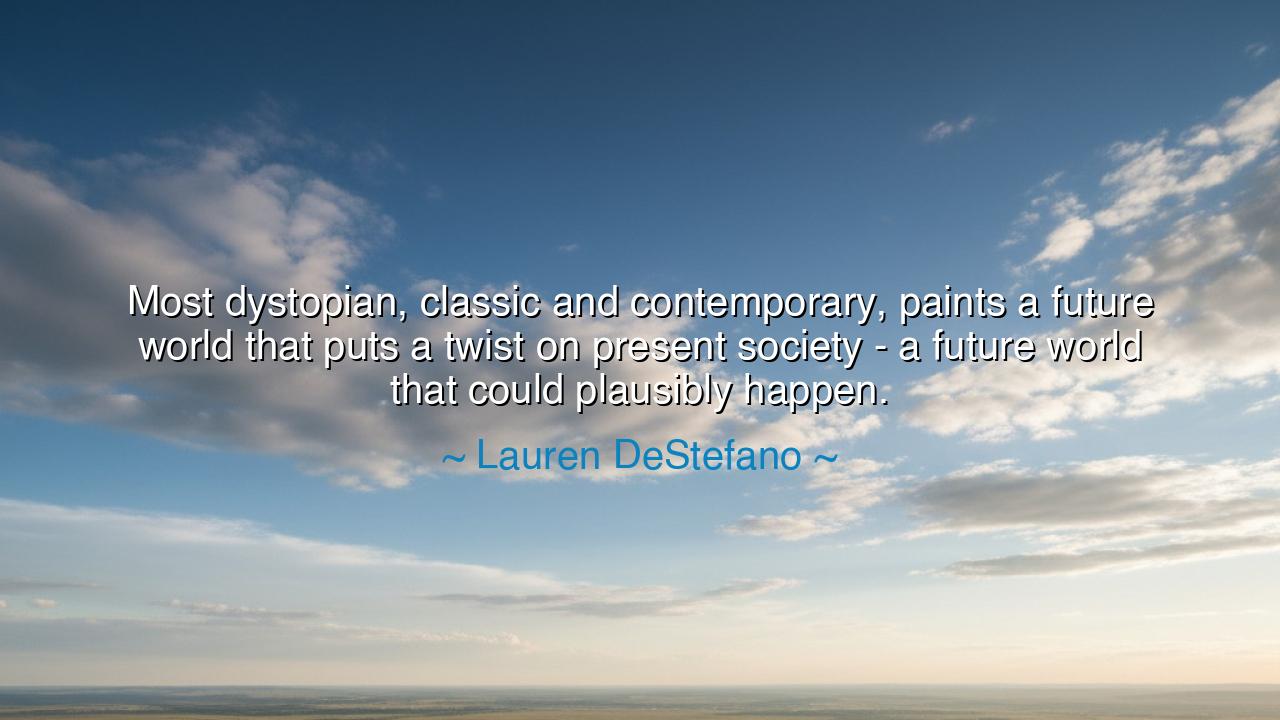
Most dystopian, classic and contemporary, paints a future world
Most dystopian, classic and contemporary, paints a future world that puts a twist on present society - a future world that could plausibly happen.






In the great tapestry of human history, the stories we tell ourselves—through myths, legends, and literature—have always held a mirror to the society from which they sprang. Lauren DeStefano’s words, "Most dystopian, classic and contemporary, paints a future world that puts a twist on present society—a future world that could plausibly happen," reveal a deep truth about the nature of dystopian fiction. These tales are not merely flights of fancy, but reflections of our current fears, desires, and mistakes. They serve as warnings, cautionary tales that illuminate paths we might walk if we continue on the course we have chosen. The future, in these stories, is often a twisted reflection of our present, magnified and distorted, showing us the consequences of choices we make today.
In the ancient world, the prophets and oracle figures often conveyed their visions of the future in a similarly twisted way. Consider the famous prophecy of the Delphic Oracle in Greece. When the great king Croesus sought advice from the Oracle before going to war, he was told that if he waged war, he would destroy a great empire. He interpreted this prophecy as a sign that he would conquer the Persians, only to find that the empire destroyed was his own. The Oracle’s words, though cryptic, spoke to a future that was possible, even probable, based on Croesus’ present actions—a reflection of the path he was already on. The ancient prophets, much like modern dystopian writers, knew that the future is not a separate entity but is shaped by the decisions and errors of today.
Similarly, in the epic tales of the Romans, there was a strong awareness of the cycle of history—the rise and fall of great civilizations. The philosopher Seneca warned of the dangers of unchecked ambition and the corruption of power, seeing in the Roman Empire a future where excess and decadence would lead to its inevitable downfall. The ancient Romans, in their literature and philosophy, often explored the idea that the present shapes the future, and that the consequences of their actions—whether in the form of moral corruption, political failure, or social unrest—were foretold in the behaviors they allowed to fester in their society. The fall of Rome itself serves as a stark reminder of how the future, though unseen, is often a twisted version of the present—a reflection of the imperial arrogance and neglect that would ultimately lead to its decline.
The concept of dystopia as a plausible future is also deeply rooted in the storytelling traditions of more recent history. Consider the novel 1984 by George Orwell, a work that painted a chilling vision of a totalitarian future where the government controls every aspect of life, from thought to action. Orwell’s dystopian society was not a far-fetched fantasy; it was a twisted version of the world he lived in—a world on the brink of fascism, totalitarianism, and war. The surveillance, the propaganda, and the loss of freedom were not simply imagined, but deeply rooted in the political and social tensions of the early 20th century. Orwell’s work, like DeStefano’s description of dystopian literature, is a stark reflection of the present society’s fears and failures, projected into the future with a dark twist.
The lesson from DeStefano’s quote, as well as from the ancient examples of prophecy and modern works of dystopian fiction, is profound: the future is not something that will simply unfold beyond us—it is shaped by our present actions. The choices we make today, the decisions we live by, and the systems we build all leave a mark on the world that will be felt by those who come after us. If we continue down a path of inequality, oppression, and ignorance, we may find ourselves living in a future that is the very nightmare we once feared. But if we choose the path of wisdom, compassion, and justice, we can create a future that reflects the best of our values.
In practical terms, this means that we must be vigilant and conscious of the world we are shaping today. Like the ancients, we must reflect on our choices, understanding that our actions—whether on a personal, political, or societal level—are creating the world of tomorrow. It means that, as citizens, we must look at the patterns of greed, injustice, and inequality in our world today and ask ourselves whether we are setting the stage for a future of suffering and decline. Conversely, we must also embrace the actions that can lead to a brighter, more inclusive, and sustainable future—where the wisdom of past generations can guide us, and where the mistakes of previous societies do not have to be repeated.
Ultimately, the future is not some distant destiny we are helpless to influence. It is the inevitable outcome of the choices we make today, shaped by our collective actions, values, and dreams. Just as the ancients believed in the power of prophecy to reveal the future, so too does dystopian literature serve as a warning. It compels us to examine our present and ask, “What kind of world are we creating?” The future, though uncertain, is not beyond our control. It is in our hands, and it is ours to shape through the choices we make today.






AAdministratorAdministrator
Welcome, honored guests. Please leave a comment, we will respond soon